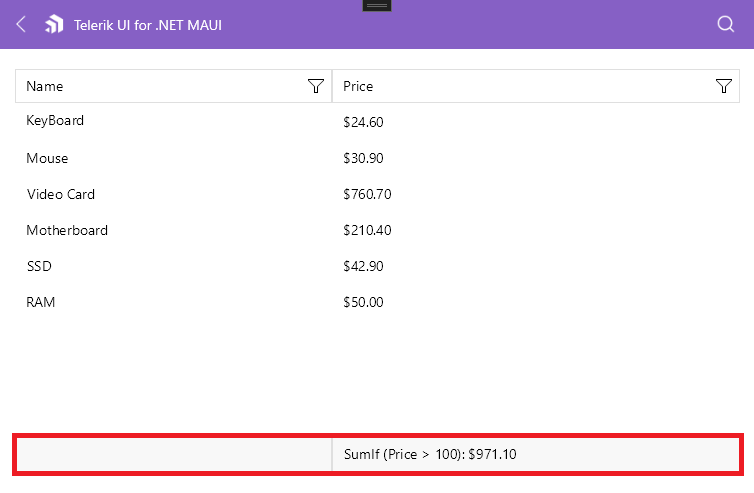.NET MAUI DataGrid Delegate Aggregate Descriptor
The DelegateAggregateDescriptor allows you to define property lookup logic and a custom function that are applied over the property values of the .NET MAUI DataGrid, which accumulates an aggregated result based on the component data.
To set up the DelegateAggregateDescriptor, use the following properties:
-
ValueLookup—Defines anIKeyLookupinstance, which retrieves the value from the underlyingViewModelthat is used for computing the aggregated value. -
Function—Defines anIAggregateFunctioninstance that performs the aggregation of the values as specified by theValueLookupproperty. -
Format—Defines the string format that will be applied over the aggregated value.
The IAggregateFunction interface exposes the following methods:
-
GetValue()—Gets the computed value. -
Accumulate(object value)—Applies the function logic to the provided value (the provided value is the extracted value from theViewModel). -
Merge(IAggregateFunction aggregateFunction)—Merges this function with another one. Used when calculating Grand Totals. -
Update(object oldValue, object newValue)—Updates the aggregate function by removing the contribution of an old value and adding a new value. This allows for efficient recalculation when data items are modified without recomputing the entire aggregation. -
Clone()—Clones the current instance of theIAggregateFunction.
The following example uses the DelegateAggregateDescriptor and a custom implementation for a SumIf function which sums the values in a range that meet a certain criteria:
1. Create a class that inherits from the IKeyLookup interface. It returns the values of a Price property declared in the business model that is of type double.
public class SumIfKeyLookUp : IKeyLookup
{
public object GetKey(object instance) => ((Data)instance).Price;
}2. Declare a class that inherits from the IAggregateFunction interface. This class will contain our logic for the SumIf function which we will later implement through XAML:
public class SumIfAggregateFunction : IAggregateFunction
{
private double value;
public double GreaterThanValue { get; set; }
public object GetValue() => $"SumIf (Price > {this.GreaterThanValue}): " + string.Format("{0:C}", this.value);
public IAggregateFunction Clone() => new SumIfAggregateFunction() { GreaterThanValue = this.GreaterThanValue };
public void Accumulate(object value)
{
var price = (double)value;
if (price > this.GreaterThanValue)
{
this.value += price;
}
}
public void Merge(IAggregateFunction aggregateFunction)
{
var myFunction = aggregateFunction as SumIfAggregateFunction;
if (myFunction != null)
{
this.value += myFunction.value;
}
}
public void Update(object oldValue, object newValue)
{
var oldPrice = (double)oldValue;
var newPrice = (double)newValue;
if (oldPrice > this.GreaterThanValue)
{
this.value -= oldPrice;
}
if (newPrice > this.GreaterThanValue)
{
this.value += newPrice;
}
}
}3. Declare the DelegateAggregateDescriptor in XAML.
<telerik:RadDataGrid x:Name="dataGrid"
UserGroupMode="Disabled"
AutoGenerateColumns="False"
UserEditMode="Cell"
ShowColumnFooters="True">
<telerik:RadDataGrid.Columns>
<telerik:DataGridTextColumn PropertyName="Name" />
<telerik:DataGridNumericalColumn PropertyName="Price"
CellContentFormat="{}{0:C}">
<telerik:DataGridNumericalColumn.AggregateDescriptors>
<telerik:DelegateAggregateDescriptor>
<telerik:DelegateAggregateDescriptor.ValueLookup>
<local:SumIfKeyLookUp/>
</telerik:DelegateAggregateDescriptor.ValueLookup>
<telerik:DelegateAggregateDescriptor.Function>
<local:SumIfAggregateFunction GreaterThanValue="100"/>
</telerik:DelegateAggregateDescriptor.Function>
</telerik:DelegateAggregateDescriptor>
</telerik:DataGridNumericalColumn.AggregateDescriptors>
</telerik:DataGridNumericalColumn>
</telerik:RadDataGrid.Columns>
</telerik:RadDataGrid>4. Define a sample data:
public class Data : NotifyPropertyChangedBase
{
private string name;
private double price;
private double deliveryPrice;
private int quantity;
public string Name
{
get => this.name;
set
{
if (value != this.name)
{
this.name = value;
this.OnPropertyChanged();
}
}
}
public double Price
{
get => this.price;
set
{
if (value != this.price)
{
this.price = value;
this.OnPropertyChanged();
}
}
}
public double DeliveryPrice
{
get => this.deliveryPrice;
set
{
if (value != this.deliveryPrice)
{
this.deliveryPrice = value;
this.OnPropertyChanged();
}
}
}
public int Quantity
{
get => this.quantity;
set
{
if (value != this.quantity)
{
this.quantity = value;
this.OnPropertyChanged();
}
}
}
}5. Set a source to the RadDataGrid.ItemsSource property:
this.dataGrid.ItemsSource = new List<Data>
{
new Data { Name = "KeyBoard", Price = 24.6, DeliveryPrice = 2, Quantity = 32 },
new Data { Name = "Mouse", Price = 30.9, DeliveryPrice = 2, Quantity = 54 },
new Data { Name = "Video Card", Price = 760.7, DeliveryPrice = 3, Quantity = 17 },
new Data { Name = "Motherboard", Price = 210.4, DeliveryPrice = 4, Quantity = 12 },
new Data { Name = "SSD", Price = 42.9, DeliveryPrice = 3, Quantity = 88 },
new Data { Name = "RAM", Price = 50, DeliveryPrice = 4, Quantity = 126 }
};The following image shows the end result.

For the DataGrid
DelegateAggregateDescriptorexample refer to the SDKBrowser Demo application and navigate to the DataGrid > Aggregates category.